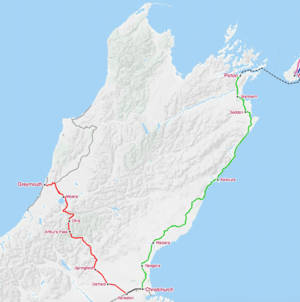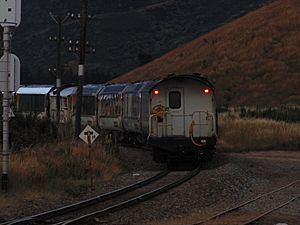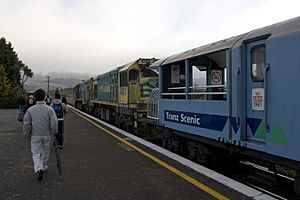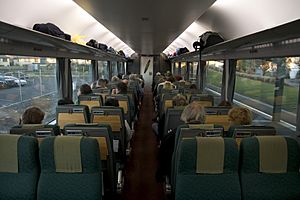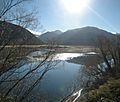TranzAlpine facts for kids
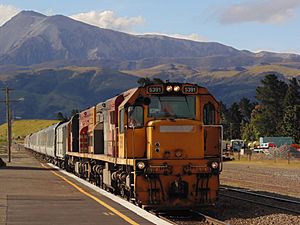
The eastbound TranzAlpine, arriving in Springfield.
|
|
| Overview | |
|---|---|
| Service type | Inter-city rail |
| Status | Operating |
| Locale | South Island, New Zealand |
| First service | 22 November 1987 |
| Current operator(s) | The Great Journeys of New Zealand |
| Former operator(s) | InterCity Rail (1987–1995) Tranz Scenic 1995–2012 KiwiRail Scenic Journeys 2012–2017 |
| Ridership | 204,000 (2006 financial year) |
| Route | |
| Start | Christchurch |
| Stops | 9 |
| End | Greymouth |
| Distance travelled | 223 km (139 mi) |
| Average journey time | 4 hours, 50 minutes |
| Service frequency | Daily each way |
| On-board services | |
| Class(es) | Scenic Class, Scenic Plus Class |
| Seating arrangements | Airline style Table bay |
| Catering facilities | On-board café |
| Observation facilities | Large windows in all carriages Open-air viewing carriage |
| Baggage facilities | Overhead glass shelves Baggage carriage |
| Other facilities | Toilets |
| Technical | |
| Rolling stock | Two DX locomotives Four to six AK carriages One to two AKCs café carriages One to two open-air observation AKV vans One AKL luggage van |
| Track gauge | 1,067 mm (3 ft 6 in) |
The TranzAlpine is a famous passenger train in New Zealand. It travels across the South Island on the Midland Line. Many people think it's one of the best train journeys in the world. This is because of the amazing scenery you see along the way.
The trip is about 223 kilometres (139 mi) long, which takes almost five hours. On this journey, the train goes through 16 tunnels and over four tall bridges called viaducts. One of these, the Staircase Viaduct, is as high as 75 metres (246 ft)!
The TranzAlpine has become very popular. In 2007, it carried 204,000 passengers. Even after the Christchurch earthquake, passenger numbers grew again. They are now even higher than before the earthquake.
Contents
History of the TranzAlpine Train
The TranzAlpine train started running on 22 November 1987. It replaced older express trains that went between Christchurch and Greymouth. This new train was designed to be a special tourist service. It used updated train cars and had a fresh new look and name.
How the Train Changed Over Time
When the TranzAlpine first started, it used refurbished train cars. One car was turned into a café car, where you could buy food and drinks. The biggest change was the windows. The old small windows were replaced with much larger ones. This gave passengers amazing views of the mountains and scenery. The other cars were also updated with new seats and carpets.
This new service quickly became a hit! In its first year, the number of passengers doubled. In January 1988 alone, over 7,000 people rode the train.
In 1988, the TranzAlpine won a special award from Tourism New Zealand. It was also named one of the top 10 "short" train journeys in the world. This was thanks to the hard work of people like Paul Teague and John Bennett.
The train was pulled by different types of locomotives, like the DC, DF, or DX class engines.
New Carriages in Recent Years
On 26 November 2012, the TranzAlpine got brand new AK class carriages. These modern cars were built in New Zealand. Since 2013, special DXC locomotives have been used to pull the train.
Why the TranzAlpine Became So Popular
The TranzAlpine kept getting more and more popular. In 1991, an old luggage car was changed into an open viewing area. This meant passengers could stand outside and get even better views of the stunning scenery.
Because so many people wanted to ride, more carriages were updated between 1994 and 1995. These new cars also had huge windows, just like the first TranzAlpine cars. Another luggage van was also changed to have two open viewing areas. This allowed even more people to enjoy the fresh air and views.
Even with these new cars, the train was still so popular that it sometimes borrowed cars from other train services!
How the Train Looked (Livery)
When the TranzAlpine started, it had a new look. It was painted dark blue with a white stripe and a red band. This was part of a new design for all New Zealand trains. Later, the red band was changed to yellow, and then to green. In 1995, the train cars got a completely new light blue paint scheme.
Special "Connoisseur" Service
In 1991, a special "Connoisseur" car was added to the TranzAlpine. This car offered extra services, like free meals, drinks, and newspapers. It was meant to give passengers a more luxurious experience. However, this special car was later moved to another train service in the North Island.
The TranzAlpine Route
The TranzAlpine train runs every day between Christchurch and Greymouth.
After leaving Christchurch, the train crosses the flat Canterbury Plains. It then follows the Waimakariri River and turns onto the Midland Line. This part of the journey takes you right through the amazing Southern Alps. You'll see the beautiful Waimakariri River gorge, pass through Arthur's Pass, and go into the long Otira Tunnel. The train also crosses the Alpine Fault, which is a major geological fault line. The journey ends in Greymouth, on the West Coast of the South Island. There are ideas to extend the service even further to Hokitika.
Images for kids


